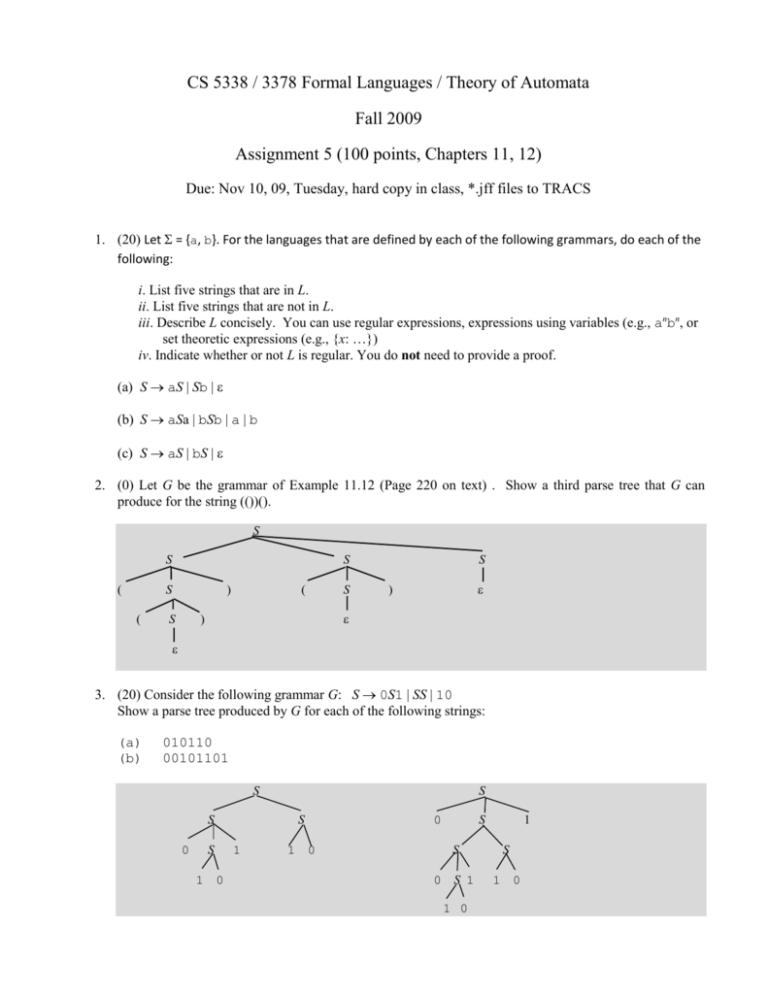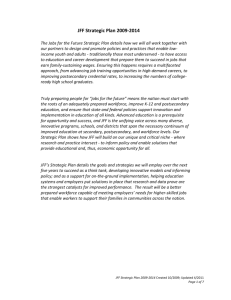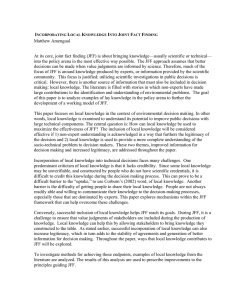Automata, Computability and Complexity with
advertisement

CS 5338 / 3378 Formal Languages / Theory of Automata
Fall 2009
Assignment 5 (100 points, Chapters 11, 12)
Due: Nov 10, 09, Tuesday, hard copy in class, *.jff files to TRACS
1. (20) Let = {a, b}. For the languages that are defined by each of the following grammars, do each of the
following:
i. List five strings that are in L.
ii. List five strings that are not in L.
iii. Describe L concisely. You can use regular expressions, expressions using variables (e.g., anbn, or
set theoretic expressions (e.g., {x: …})
iv. Indicate whether or not L is regular. You do not need to provide a proof.
(a) S aS | Sb |
(b) S aSa | bSb | a | b
(c) S aS | bS |
2. (0) Let G be the grammar of Example 11.12 (Page 220 on text) . Show a third parse tree that G can
produce for the string (())().
S
S
(
S
S
(
)
S
(
S
S
)
)
3. (20) Consider the following grammar G: S 0S1 | SS | 10
Show a parse tree produced by G for each of the following strings:
(a)
(b)
010110
00101101
S
S
S
0
1
S
1
0
S
0
1
0
S
1
S
0
S 1
1 0
S
1
0
4. (30) Show a context-free grammar for each of the following languages. For each grammar, create *.jff
with the given file name and submit to TRACS, then copy the grammar in *.jff below. Note that (a) ~ (h) have
corresponding subquestions in Question 5.
(a) BalDelim = {w : where w is a string of delimeters: (, ), [, ], {, }, that are properly balanced}.
a5-4a.jff
(b) {aibj : 2i = 3j + 1}.
a5-4b.jff
(c) {w {a, b}* : #a(w) = 2 #b(w)}.
a5-4c.jff
(d) {w {a, b}* : w = wR}.
a5-4d.jff
(e) {w {a, b}* : every prefix of w has at least as many a’s as b’s}.
a5-4e.jff
(f) {anbm : m n, m-n is even}.
S aSb | Sbb |
(g) {xcn : x {a, b}* and (#a(x) = n or #b(x) = n)}.
S A | B
A B a B A c | B
B bB |
B A b A B c | A
A aA |
(h) {bi#bi+1R : bi is the binary representation of some integer i, i 0, without leading zeros}. (For example
101#011 L.)
L can be written as:
0#1 {1k#0k1 : k > 0} {u01k#0k1uR : k 0 and u 1(0 1)*}
So a grammar for L is:
S 0#1 | 1 S1 1 | 1 S2 1
S1 1 S1 0 | #0
S2 1 S2 1 | 0 S2 0 | 0 A 1
A1A0|#
5. (30) Build a PDA to accept each of the following languages. For each PDA, first use a sextuple to define
it. Then, create *.jff with the given file name and submit to TRACS. Then, cut and paste the figure in *.jff
below. The sample solutions may not contain both forms of the PDA definitions. However, you should do
both. Note that (a) ~ (h) have corresponding subquestions in Question 4. This does not mean you can use
JFLAP to automatically convert the grammars in Question 4 to corresponding PDAs because the
definition of PDA in JFLAP is different from the one we use.
(a) BalDelim = {w : where w is a string of delimeters: (, ), [, ], {, }, that are properly balanced}.
a5-5a.jff
(b) {aibj : 2i = 3j + 1}.
a5-5b.jff
(c) {w {a, b}* : #a(w) = 2#b(w)}.
a5-5c.jff
(d) {w {a, b}* : w = wR}.
a5-5d.jff
(e) {w {a, b}* : every prefix of w has at least as many a’s as b’s}.
a5-5e.jff
(f) {anbm : m n, m-n is even}.
M = ({1, 2, 3, 4}, {a, b }, {a}, , 1, {3}), where =
{
((1, a, ), (1, a)),
((1, b, a), (2, )),
((1, , ), (3, )),
((2, b, a), (2, )),
((2, , ), (3, )),
((3, b, ), (4, )),
((4, b, ), (3, )) }
(g) {xcn : x {a, b}*, #a(x) = n or #b(x) = n}.
M will guess whether to count a’s or b’s. M = ({1, 2, 3, 4}, {a, b, c}, {c}, , 1, {1, 4}), where =
{
((1, , ), (2, )),
((1, , ), (3, )),
((2, a, ), (2, c)),
((2, b, ), (2, )),
((2, , ), (4, )),
((3, a, ), (3, )),
((3, b, ), (3, c)),
((3, , ), (4, )),
((4, c, c), (4, )) }
(h) {bi#bi+1R : bi is the binary representation of some integer i, i 0, without leading zeros}. (Example:
101#011 L.)
M = ({0, 1, 2, 3, 4, 5, 6, 7}, {0, 1, #}, {0, 1}, , 0, {3, 4, 7}), where =
{
((0, 1, ), (1, 1)),
/* The normal case, where w starts with a 1.
((0, 0, ), (5, )),
/* The special case of the string 0#1.
((1, 0, ), (1, 0)),
/* Push 0’s and 1’s until the # is read.
((1, 1, ), (1, 1)),
((1, #, ), (2, )),
/* At the #, go to state 2 and start popping.
((2, 0, 1), (2, )),
/* First half had 1. So this 0 is creating a carry bit.
((2, 1, 0), (3, )),
/* Reading the 1 that replaces a 0.
((2, 1, ), (4, )), /* If the first half is 1*, then this is the 0 that starts the second half.
((3, 0, 0), (3, )),
/* Handling the part after the 1 got added. All chars must match.
((3, 1, 1), (3, )),
((5, #, ), (6, )),
/* A little FSM to finish reading 0#1.
((6, 1, ), (7, )) }
(i) L1*, where L1 = {xxR: x {a,b}*}.
M = ({1, 2, 3, 4}, {a, b}, {a, b, #}, , 1, {4 }), where =
{ ((1, , ), (2, #)),
((2, a, ), (2, a)),
((2, b, ), (2, b)),
((2, , ), (3, )),
((3, a, a), (3, )),
((3, b, b), (3, )),
((3, , #), (4, )),
((3, , #), (2, #)) }
(j) {anbm : m n 2m}.
M = ({1, 2}, {a, b}, {a}, , 1, {1, 2}), where =
{ ((1, a, ), (1, a)),
((1, , ), (2, )),
((2, b, a), (2, )),
((2, b, aa), (2, )) }.
(k) {anbman : n, m 0 and m is even}.
file name: a5-5k.jff (in JFLAP, use finite state acceptance)
6. (10 bonus) The definition of PDA in JFLAP is different from ours. However, you can manage to run and
test the PDAs built for Question 5, (a) ~ (e). Describe how.
Hint 1: which acceptance option to use, finite state or empty stack?
Hint 2: for some of them, simplying choosing an acceptance option wouldn’t work. You may need to
modify the original PDA.









